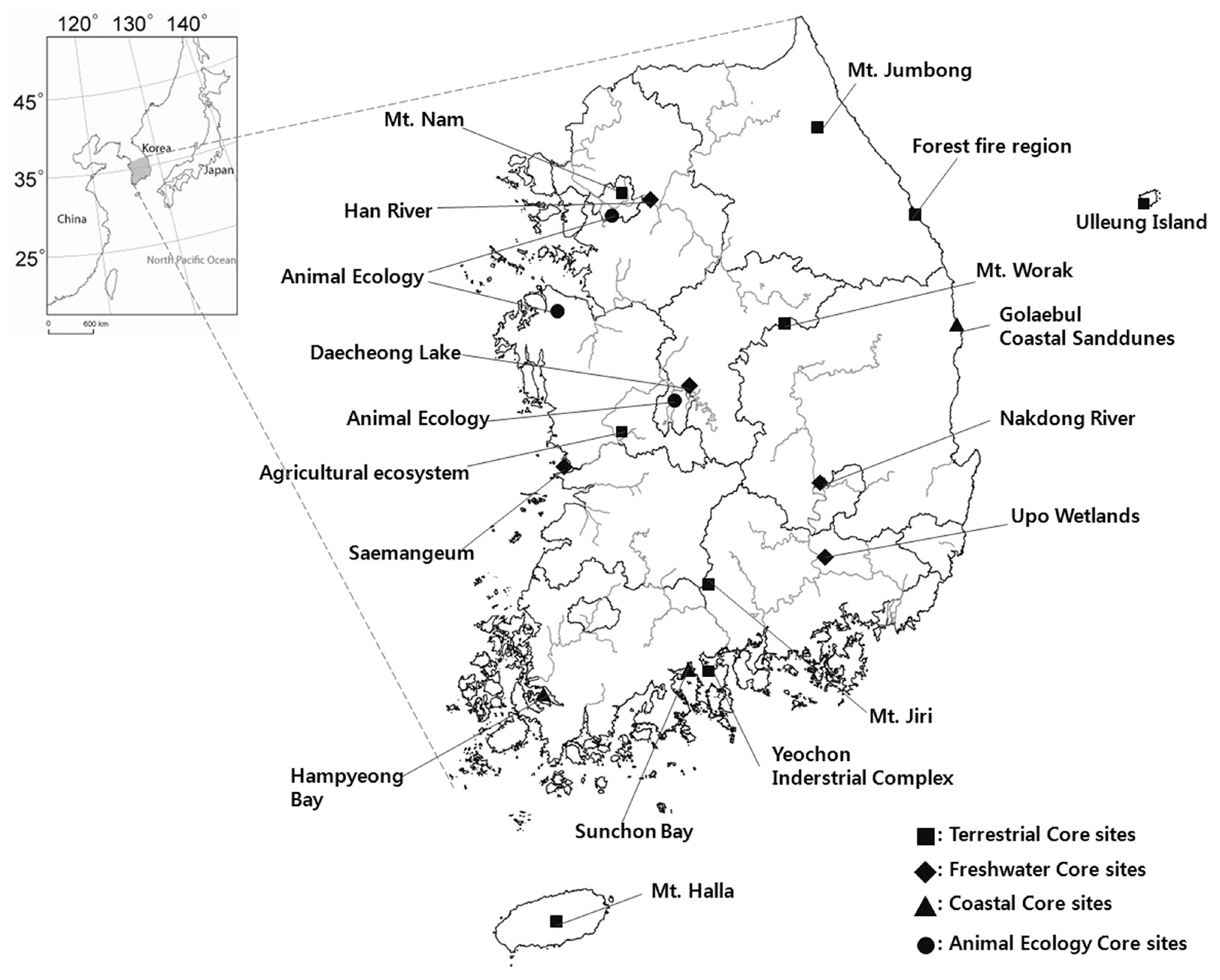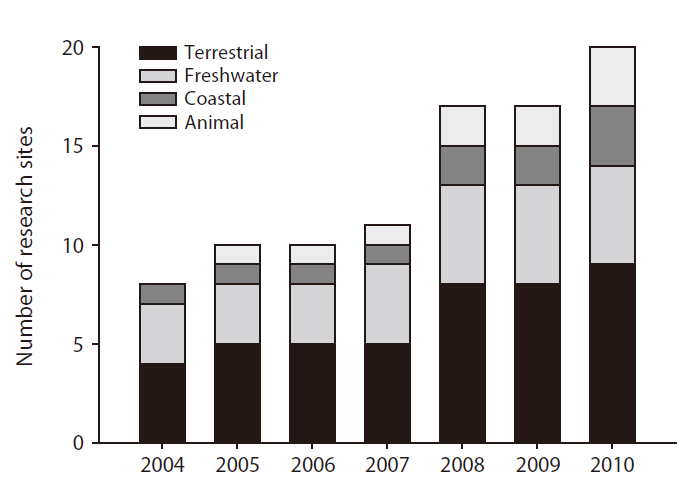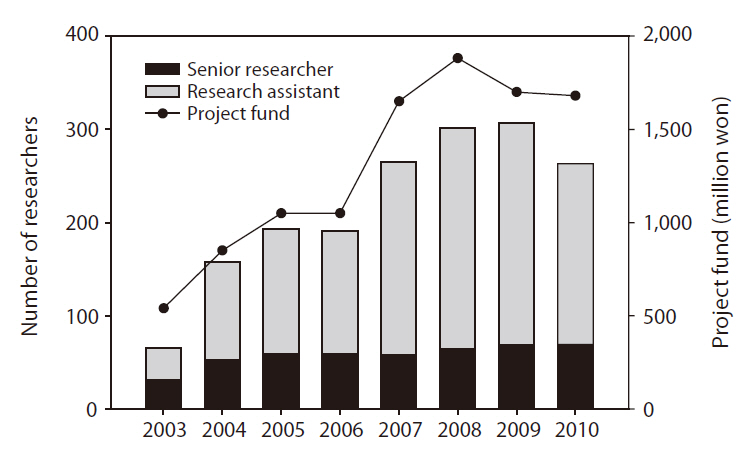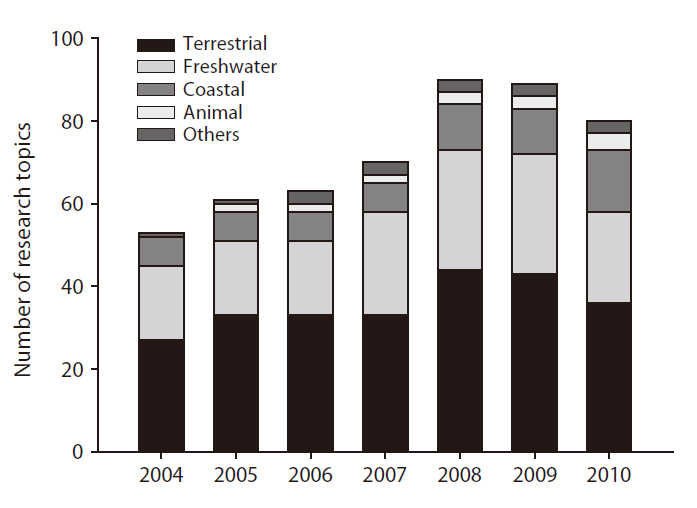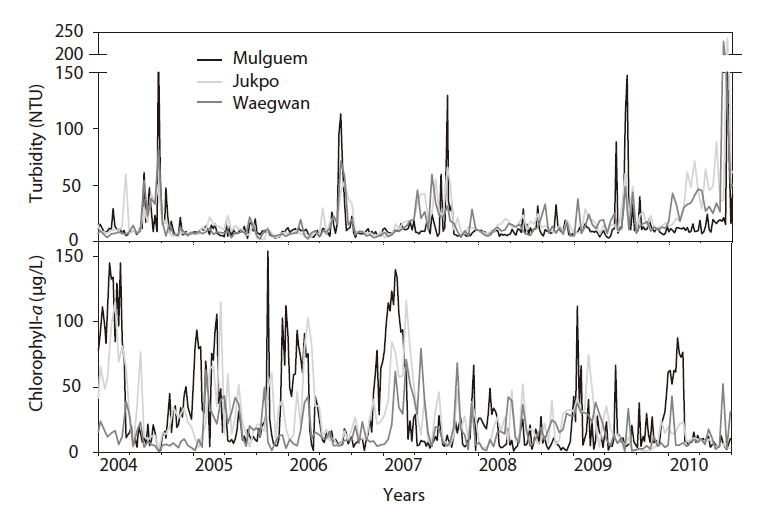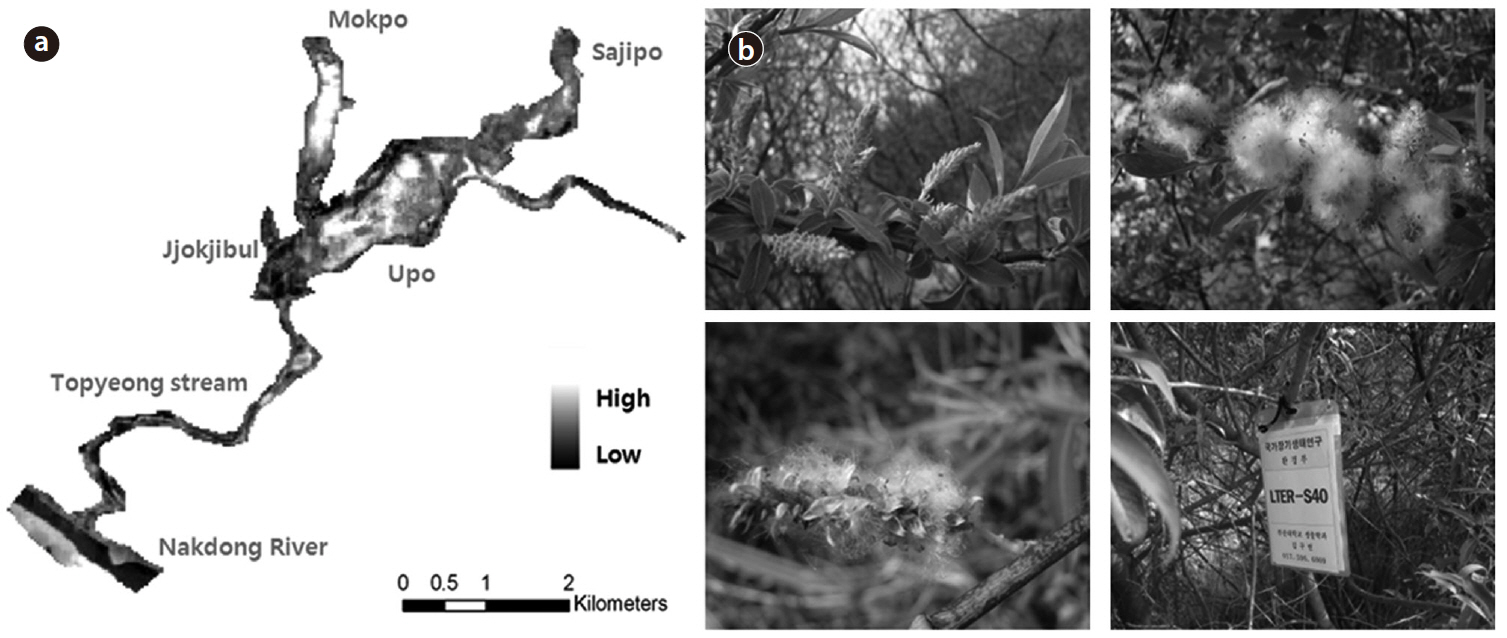



Natural ecosystems have been disturbed and biodiversity is rapidly decreasing due to climate change and environmental pollution (Vitousek 1994, Root et al. 2003,Malcolm et al. 2006). Increases in CO2 emissions (Cramer et al. 2001), ozone depletion (Pienitz and Vincent 2000),typhoon intensity (Webster et al. 2005), sea level rises(Wigley and Raper 1992), geographical range shifts (Walther et al. 2002), and pollution caused by human activities are main cause and results. Some ecological change is swift but most responses, including climate change,can only be recognized by consistent observation (Callahan 1984). Although some long-term studies were available,they were usually limited to a single topic in a restricted area.
Long-Term Ecological Research (LTER) was organized in the USA in the 1980s to identify ecosystem dynamics over the long-term periods (Caraco and Lovett 1989, Robertson 2008). In 1993, the LTER program in many countries established the International Long-Term Ecological Research (ILTER) network, which currently consists of 40 countries on six continents (International Long Term Ecological Research 2010). Corresponding with national assistance for ecosystem studies in other countries, the Korean Ministry of the Environment (MOE) also began natural environment and conservation research. However, most national research were conducted for 1 to 3 years and focused on current problems. Thus, gradual ecosystem changes were difficult to trace within the program. While climate change-related issues in the South Korea have also increased (Shao 1996, Ho et al. 2003, Rebstock and Kang 2003), the need to initiate nationally managed long-term research has been proposed.
Korea National Long-Term Ecological Research (KNLTER) focuses on continuing long-term research on natural ecosystems to make provisions against climate change and to provide a national database to manage endangered species and ecosystems. KNLTER aims to increase the understanding of ecosystem responses and, consequently, contribute to natural ecosystem conservation.
This article reviewed national ecological research after the 1960s in Korea to define the necessity for LTER, the development of KNLTER, and to evaluate their achievements
into four main divisions (terrestrial, freshwater, coastal ecosystem, and animal ecology). Furthermore, we described several improvement needs to enhance development of LTER.
LONG-TERM ECOLOGICAL RESEARCH IN SOUTH KOREA
Most domestic studies were conducted for fragmented time scales, so it has been difficult to understand the continuous environmental change response (Kim 2000). Limited regular ecological monitoring was performed in South Korea from the 1960s to the 1990s. The Korean Association for Conservation of Nature conducted irregular ecological surveys on major ecological sites from 1964 to 1982. The Korean National Council for Conservation of Nature has held a nation-wide academic survey once per year since 1982 but they mainly include the island area.
The MOE proceeded to survey closed ecosystems in 1983 and they produced an actual vegetation map, which was the outcome of First National Survey of the Natural Environment in Korea from 1986 to 1990. A natural environmental database was established during the Second National Survey of the Natural Environment in Korea (1997-2003). In 2006, the Third National Survey of the Natural Environment in Korea was begun and will be completed in 2012 with an enhanced natural environmental database consisting of forest, river, and estuarine ecosystems (CBD-CHM KOREA 2010). However, these research programs only conducted temporary surveys on different ecosystems, so they could not follow the sequential progress of a particular response, including climate change and pollution.
The Korea Forest Service conducted biodiversity and ecosystem change research on terrestrial ecosystems from 1994 to 2008. The Korea Water Resources Corporation has continued limnological studies in freshwater ecosystems for more than 30 years. Furthermore, 15-year studies on water quality, phytoplankton and zooplankton grazing, exotic fish, and ecological modeling were conducted in the lower Nakdong River. An intertidal west and south coast survey was conducted in 1989. Other surveys were conducted in 1991 and 1996, but included only the western intertidal area. These coastal surveys mainly focused on listing flora and fauna. The MOE proceeded to conduct a mudflat survey on the west and south coast from 1996 to 2000. However, it was only a temporary survey around the site. Unlike previous research programs, these studies surveyed similar areas over multiple time series. Nevertheless, they did not have sufficient research frameworks and sampling to analyze integrated ecosystem change.
The initial blueprint for KNLTER was admitted to the Eighth International Congress of Ecology, which was held in Seoul, Korea. The Ecological Society of Korea accomplished the Nation’s Baseline Ecological Research (NBER), and NLTER frameworks started to organize (Ministry of Environment 2003). NBER focused on initializing the NLTER research framework and creating standard protocols to monitor long-term changes in ecosystems, including climate change and environmental pollution. This project included a terrestrial ecosystem (Mt. Jumbong), a freshwater ecosystem (Nakdong River), a coastal ecosystem (Hampyeong Bay), and an animal study (bird and insects) as primary core sites (Fig. 1).
PROGRESS AND CURRENT STATUS OF KNLTER
KNLTER was started in 2004 with its first phase (2004-2006), passed through its second phase (2007-2009), and orgis now in the second year of the third phase (Ministry of Environment 2010). The third phase is composed of a 4-year research project that will be completed in 2013. Core site selection and application of standard protocols, weather stations, and a database system were the main objectives during the first phase. Initial research focused on selecting indicator species against ecosystem change. Then, an ecological study of indicator species, monitoring network enhancement, and foundation work on ecological modeling were primary subjects of the second phase. The objectives of the third phase include a multidisciplinary approach with the LTER dataset, modeling studies, and collaboration research within core sites
The number of KNLTER research sites is increasing, and the sites include diverse ecosystems (Figs. 1 and 2). In 2004, research began with eight core sites including four terrestrial ecosystems (Mt. Jumbong, Mt. Worak, Mt. Jiri, and Mt. Nam), three freshwater ecosystems (Nakdong River, Han River, and the Upo Wetlands), and one coastal ecosystem (Hampyeong Bay). The forest fire region in Samcheok was added as a terrestrial ecosystem and a magpie (
As the number of research sites increased, the program could assist various ecosystems against change. Ulleung Island (terrestrial ecosystem) and Sunchon Bay (coastal ecosystem) were included beginning with the third phase in 2010. Now, the number of core sites has increased to 20, and KNLTER promotes research on various land and island ecosystems.
The number of researchers and research funds increased until the second phase (Fig. 3). Then, total funding decreased in 2009 and 2010, and the number of researchers was reduced. Due to the decrease in the number of researchers, research topics were concentrated to 90% compared with the total number of subjects in the second phase. More than 250 researchers have participated in this project since 2007, which will contribute to the development of the LTER network. The number of senior researchers increased gradually during the project period, but the number of assistant researchers fluctuated with total research funding. Compared with the initial research budget plan, only 25% was executed during the 7 years.
Research topics varied depending on site conditions, including a reduction in researchers; however, the total number increased (Fig. 4). The program began with 53 topics, including 27 subjects on terrestrial ecosystems, 18 subjects on freshwater ecosystems, seven subjects on coastal ecosystems, and one on research database management. Site expansion and researcher supplements during the second phase increased the number of topics to 89, including 43 subjects on terrestrial ecosystems, 29 subjects on freshwater ecosystems, 11 subjects on coastal ecosystems, and three subjects on animal ecology, climate, international cooperation, and database management. In the first year of the third phase, subjects in most divisions were reduced, except the coastal and animal ecology division, which expanded to new sites (terrestrial, 36; freshwater, 22; coastal, 15; animal, 4; research management, 3). The main subjects, including climate and environment monitoring and ecological characteristics of target species, were continued, but studies on food web structure, heavy metal accumulation, and non-target species were suspended during the first year of the third phase. KNLTER is currently composed of 45% terrestrial subjects, 27.5% freshwater subjects, 19% coastal subjects, 5% animal ecology subjects, and 4% research management subjects.
KNLTER also produced educational materials to increase public awareness of LTER research and ecosystems. Pamphlets describing indicator species were organized by each research division and were distributed to educational centers. We also revealed our field data to show the status of the research sites. For example, real-time environment log data (weather condition and water quality) is displaying at the Upo Wetland Educational Center.
CURRENT KNLTER RESEARCH TOPICS
The purpose of LTER in Korea is to accumulate ecological knowledge on environmental change and to provide a basis for future ecosystem management planning by the government. To satisfy these goals, the program also includes diverse research topics, which can provide ecological suggestions against climate change and pollution to policy makers.
>
Climate research and project management
Local climate is analyzed to assess the change in frequency and intensity of extreme weather events, which can influence an ecosystem. The program also used extreme climate indicators such as the Nino 3.4 sea surface temperature anomaly, the southern oscillation index, and the Arctic oscillation index. International cooperation participates in the ILTER annual coordinating committee meeting and presents KNLTER activities at the ILTER meeting. They also organize the ILTER East Asia-Pacific (ILTER-EAP) regional meeting and present the ILTER-EAP region report to facilitate Asian-Pacific networks. GIS-DB manages the main server of the LTER database to collect field data from researchers. They also map the results and distribute activities and publications to the public.
This division collects basic data on meteorological factors such as temperature, precipitation, humidity, radiation, air pollution, and CO2 flux using towers installed at three sites on Mts. Nam, Jumbong, and Jiri. The vegetation dynamics section monitors mortality and natality of woody plants and investigates coverage changes in shrubby and herbaceous plants that appear in permanent plots. The primary productivity and biogeochemical cycle section measures primary productivity, litter production and decomposition, soil nutrients content, and plants and explores the movement of biogeochemical elements between the abiotic environment and living systems in relation to climate change. The phenology section monitors leaf unfolding, flowering, flower shedding, and tinge times and investigates the correlation between those data and meteorological factors. The biodiversity section monitors the ecology of several species of insects, amphibians, reptiles, and birds.
The freshwater ecosystem division focuses on five core sites including lotic freshwater ecosystems (Nakdong and Han rivers) and lentic freshwater ecosystems (Upo Wetlands and Saemangeum and Daecheong lakes). Each core site includes observations and research on water quality, phytoplankton, zooplankton, aquatic plants, aquatic insects, fishes, and birds. The water quality section monitors limnological characteristics of core sites, and the plankton section studies population dynamics and their correlation with the environment. The aquatic plants section focuses on phenological patterns and the community composition of macrophytes. The aquatic insects, fish, and bird section surveys the biodiversity of core sites, and studies ecological characteristics of indicator species. The aquatic insect section focuses on larval growth patterns depending on temperature changes. The fish section surveys changes in the distribution of cold-water fish and exotic species. The bird section monitors the wintering population of migratory birds to study potential habitat ranges. Each site’s record was compared with climatic factors, and these data were used to make an ecological model to predict the impact of environmental change on freshwater ecosystems. Additionally, we are displaying our real-time environmental data at the Ecological Education Center to increase people’s recognition of freshwater ecosystems and their important roles.
The coastal ecosystem division monitors environmental factors including climate, water quality, geomorphology, and indicator species. The benthic diatom and invertebrates section surveys spatial distribution to monitor habitat changes and responses. The seaweed section conducts research on community composition and relates the changes to environmental factors. The halophyte, dune vegetation, and dune insect section monitors the spatial distribution of habitats. The GIS-RS section surveys topographic changes in the mudflat and dune environments using a light detection and ranging system. In particular, each research section collaborates to study spatial distribution patterns in the coastal environment.
The animal ecology division monitors four indicator species ranging from insects, birds, and mammals. The bird ecology section studies the annual variation in breeding success of magpies (P.
SUMMARY OF CURRENT RESULTS IN MAIN RESEARCH FIELDS
Over the past 7 years, the KNLTER program has provided the outcomes of all research programs as they relate to climate change and environmental pollution. Many studies considered the ecological characteristics of indicator species and the population response to climate change and pollution. The large number of research projects limits their description; however, here is a small sample of the results
The freshwater ecosystem and limnological studies identified that summer rainfall has been increasing, and this was accompanied by a decrease in winter rainfall during the same period. This result was correlated to changes in phytoplankton dynamics, which respond to changes in turbidity and other water quality param-
eters (Fig. 5). Background environmental factors such as climate, water chemistry, and soil characteristics at each LTER site have been monitored and delivered to other researchers who are more involved with that data.
Population dynamics studies on
Research on species response to temperature change at Mt. Nam has shown that the leaf-out period for oak trees is occurring 15 days earlier than in 1996, and that the mean temperature in the Seoul area has increased 0.34°C. The freshwater research group and the coastal ecosystem division have been monitoring changes in the phenology of aquatic macrophytes (Fig. 6). The coastal ecosystem division is still gathering data on halophytic vegetation phonological responses to temperature change. Further research on seaweed responses to changes in temperature have identified an increase in the Rhodophyta/Phaeophyta (R/P) ratio, which has a direct correlation to increasing marine water temperatures. The average value in Hwampyeong Bay has gradually increased to the point where Hwampyeong Bay has been categorized as a subtropical marine ecosystem based on this R/P value.
Studies on zooplankton community composition and changing salinity environments began in 2007 at Seamangeum and have shown that the site is dominated by marine copepods. However, the site has been dominated by brackish/freshwater copepods since 2009. The salinity range of Saemangeum has also decreased during the same period; thus, changes in copepod dominance appear to be related to this decrease in salinity; however, further research is needed.
The amphibian and reptile division studied the population on Worak Mountain and found that amphibian reproduction had a negative relationship to increased rainfall during the mating period. The reptile population showed a stronger relationship to changes in temperature relative to rainfall.
Studies on migratory birds have shown that the wintering ranges and the appearance of summer visitors have begun to extend further north due to changes in temperature. The coldwater fish work is still ongoing but general results have shown no statistical variances. For example, Jacana appeared in the Upo Wetland for the first time in 2004, and again in 2005 and 2007-2010. The first groups (2004-2005) failed to reproduce; however, the individuals that nested from 2007-2010 produced fledglings
Surveys on exotic species in Upo have shown that largemouth bass (
Studies on P.
IMPROVEMENTS NEEDS AND FURTHER RESEARCH
Currently, KNLTER is processing the seventh year of research and has 20 research sites with 80 topics. An internal research framework and database management system was established during the last project period. We need to corroborate some checkpoints to improve our research programs, which will correspond with the objectives.
All field data should be collected with the same format so that ecosystem changes caused by climate change or environmental pollution can be compared. We have standard protocols created from primary research; but we still need to check our standard data format for accumulating a long-term database before beginning the next period. The US LTER, China Ecological Research Network (CERN), Taiwan Long-Term Ecological Research Network, and the Japan Long Term Ecological Research Network adopted ecological metadata language developed by the Ecological Society of America to exchange long-term data more efficiently (Chinese Ecosystem Research Network 1993). ILTER researchers can share their information based on this foundation framework using the same methods and data format (Lane 1997, Muller et al. 2010). Moreover, we should elaborate on our international standard data tools to accomplish multidisciplinary research.
A LTER workshop should be held regularly for all participant topics to accelerate information exchange through collaborative research. KNLTER contains diverse topics and researchers in terrestrial, freshwater, and coastal ecosystems. Although division managers encouraged an exchange program, we have had limited collaborative research at the same research site. An official LTER workshop should be established to present core-site research and discussions for further research. For example, an all-scientists meeting is held at the US LTER every year. All of the LTER researchers, people from the government and collaborative research stations, and the public attend to exchange their opinions (Muller et al. 2010). We have these kinds of meetings in private or irregularly. A date for a LTER annual meeting needs to be identified to evaluate our progress more meaningfully.
An organized international network should be established for efficient global research. Climate change and pollution is not simply a domestic problem. We need to collaborate with the global climate change research network and domestic network to predict ecosystem changes in Korea. KNLTER should strengthen its relationship with the East Asia network to share the ecological database. South Korea is located in the East Asia-Pacific network region, which covers China, Taiwan, Japan, Mongolia, Australia, and Thailand. In 2010, there was discussion about collaborative research during the Fourth East Asian Federation of Ecological Societies meeting held in Sangju, South Korea. East Asia-Pacific network members visited KNLTER research sites during the conference. The LTER program is based on network research; thus, LTER members should consider international concerns that can be related to national issues.

